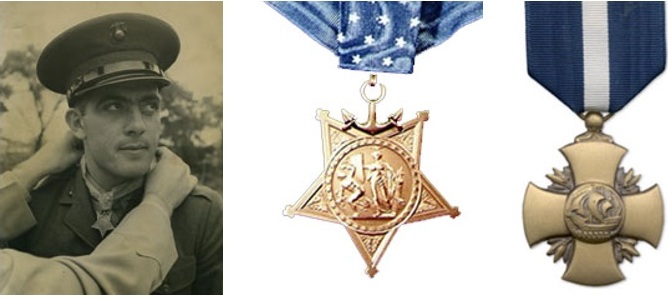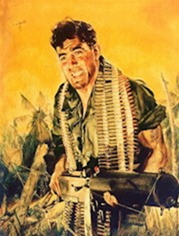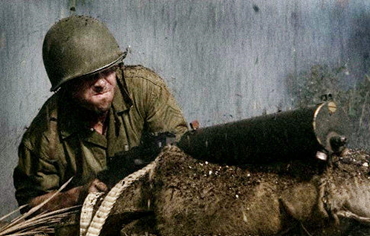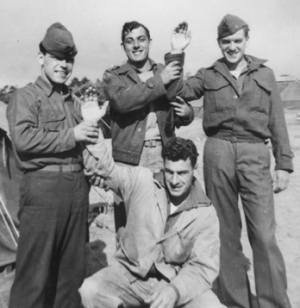Gunnery Sergeant “Manila” John Basilone USMC
John Basilone (November 4, 1916 – February 19, 1945) was a United States Marine Gunnery Sergeant who received the nation’s highest military award for valor, the Medal of Honor, for heroism during the Battle of Guadalcanal in World War II. He was the only Marine enlisted man to receive both the Medal of Honor and the Navy Cross in World War II.
He served three years in the United States Army with duty in the Philippines. He enlisted in the Marine Corps in 1940, claiming that the army “wasn’t tough enough” and was deployed to Guantánamo Bay, Cuba, the Solomon Islands, and Guadalcanal where he held off 3,000 Japanese troops after his 15-member unit was reduced to two other men. On the first day of the Battle of Iwo Jima, he was killed in action, after which he was posthumously awarded the Navy Cross for extraordinary heroism. He has received many honors including being the namesake for streets, military locations, and a United States Navy destroyer.
Basilone was born in his parents’ home on November 4, 1916 in Buffalo, New York, the sixth of 10 children. His father, Salvatore Basilone, emigrated from Naples in 1903 and settled in Raritan, New Jersey. His mother, Theodora “Dora” Bencivenga, was born in 1889 and grew up in Manville, but her parents, Carlo and Catrina, also came from Naples. His parents met at a church gathering and married three years later. Basilone grew up in the nearby Raritan Town (now Borough of Raritan) where he attended St. Bernard Parochial School. After completing middle school at the age of 15, he dropped out prior to attending high school
Basilone worked as a golf caddy for the local country club before joining the military. He enlisted in the United States Army in July 1934 and completed his three-year enlistment with service in the Philippines, where he was a champion boxer. John later looked back so fondly on his time in the Philippines that his buddies nicknamed him “Manila John”. In the Army, Basilone was initially assigned to the 16th Infantry at Fort Jay, before being discharged for a day and reenlisting and being assigned to the 31st Infantry.
After he was released from active duty, he returned home and worked as a truck driver in Reisterstown, Maryland. After driving trucks for a few months, he wanted to go back to Manila, and believed he could get there faster as a Marine than as a soldier in the army.
He enlisted in the Marine Corps in July 1940 from Baltimore, Maryland. He went to recruit training at Marine Corps Recruit Depot Parris Island, followed by training at Marine Corps Base Quantico and New River. The Marines sent him to Guantánamo Bay, Cuba for his next assignment, and then to Guadalcanal in the Solomon Islands as a member of Dog Company 1st Battalion, 7th Marine Regiment 1st Marine Division.
Sunday, October 25 1942: The Night A Marine Legend Was Born
Guadalcanal was a fierce clash of national wills. Bloodied and humiliated by the sneak attack on Pearl Harbor, American armed forces were on the comeback trail less than six months after the debacle. At Guadalcanal, a disease infested island, two superb military organizations met each other for the first time in land combat — bayonet to bayonet — in a contest only one army could win.
During the Battle for Henderson Field, his unit came under attack by a regiment of approximately 3,000 soldiers from the Japanese Sendai Division. On October 24, 1942, Japanese forces began a frontal attack using machine guns, grenades, and mortars against the American heavy machine guns. Basilone commanded two sections of machine guns that fought for the next two days until only Basilone and two other Marines were left standing. Basilone moved an extra gun into position and maintained continual fire against the incoming Japanese forces. He then repaired and manned another machine gun, holding the defensive line until replacements arrived. As the battle went on ammunition became critically low. Despite their supply lines having been cut off by enemies in the rear, Basilone fought through hostile ground to resupply his heavy machine gunners with urgently needed ammunition. When the last of it ran out shortly before dawn on the second day, Basilone held off the Japanese soldiers attacking his position using his .45 pistol. By the end of the engagement Japanese forces opposite their section of the line were virtually annihilated. For his actions during the battle, he received the United States military’s highest award for valor, the Medal of Honor.
Afterwards, Private First Class Nash W. Phillips, of Fayetteville, North Carolina, recalled from the battle for Guadalcanal:
“Basilone had a machine gun on the go for three days and nights without sleep, rest, or food. He was in a good emplacement, and causing the Japanese lots of trouble, not only firing his machine gun, but also using his pistol.”
The United States Marines were determined to keep their small foothold of Henderson Field and the Japanese were equally determined to drive them into the sea. During the protracted battle which lasted for six months, the struggle to “own” Henderson Field came to a bloody climax on Sunday night 25, October, 1942.
At Lunga Ridge — about 1,000 yards south of Henderson Field it was raining torrents, creating miserable, bottomless mud — typical Guadalcanal weather. The MARINES manning the main line of defense were exhausted. For two days Japanese human wave assaults had been flung against them. Each time the charging enemy had been driven off — but the weary MARINES knew their tough adversaries weren’t through. The Japanese would gather reinforcements and return.
About midnight, from the gloom of ink-black darkness came hundreds of screaming Japanese troops. Throwing themselves on the flesh-cutting barbed wire, the first of the waves formed human bridges for their comrades to leap across. One of the Marine section leaders facing them was Sergeant “Manila John” Basilone. An experienced machine gunner, Basilone knew his guns would be tested to their mechanical limits. It would be up to him to keep them firing.
During the attack when grenades, small arms and machine guns were ripping the night and exploding human flesh splattered friend and foe, Sergeant Basilone stayed with his malaria-ridden men. Repeatedly repairing guns and changing barrels in almost total darkness, he ran for ammo or steadied his terrified men who were firing full trigger to keep a sheet of white-hot lead pouring into the ranks of the charging Japanese.
Bodies piled so high in front of his weapons pits they had to be reset so the barrels could fire over the piles of corpses. Not even the famous water-cooled heavy machine guns could stop all the assaults and one section of guns was overrun. Two men killed, three others wounded.
Basilone took one of his guns on his back and raced for the breach in the line. Eight Japanese were surprised and killed. The guns were jammed by mud and water and a few yards away the Japanese were forming for another charge. Frantically stripping mud from the ammo belts men fed them into the guns as Basilone cleared jams and sprayed the fiendish troops rushing at his positions with razor sharp bayonets and hands full of grenades.
Sometime after 0200 the firing died down. No one relaxed. At 0300 the final remnants of the Sendai Regiments with their officers prepared themselves for a final Banzai charge. The full weight of the fanatical Japanese seemed to fall on Basilone’s men. But he had set up a cross fire which smashed the charge. Dropping to the mud, still screaming Colonel Sendai’s remnants crawled forward trying to reach their tormentors. Depressing the muzzles of his weapons — Basilone destroyed them. Nash Phillips lost a hand fighting next to his Sergeant. He was surprised to see John Basilone appear next to his bed a little while after dawn. “He was barefooted and his eyes were red as fire. His face was dirty black from gunfire and lack of sleep. His shirt sleeves were rolled up to his shoulders. He had a .45 tucked into the waistband of his trousers. He’d just dropped by to see how I was making out; me and the others in the section. I’ll never forget him. He’ll never be dead in my mind!”
With dawn the battlefield was strewn with dead and wounded Americans and Japanese — but Henderson Field still belonged to the Americans and its ownership would never be seriously challenged again. At least 38 dead Japanese were credited to Sergeant Basilone — many were killed with his Colt .45 at almost arm’s length. Just 26 years old, Manila John Basilone had entered the ranks of the Marine Corps pantheon of heroes — and shortly America would take the big, handsome Marine with jug ears and a smile like a neon sign to their hearts. The legend of a “Fighting Sergeant” was born.
When the battle was over and his squad members interviewed, Sergeant Basilone was credited by his men for his will to fight and ability to inspire them in a night of cold fear none ever forgot.
Within a short time the Japanese evacuated Guadalcanal and prepared to meet other Marine invasions of their strongholds elsewhere in the Pacific. American fighting men had proven they could beat the best of the best, the most experienced troops Japan could throw at them. After Guadalcanal the Japanese high command had a fresh respect for the MARINES. They would be forced to meet time and time again as America pressed across the Pacific toward their homeland.
In 1943, after receiving the Medal of Honor, he returned to the United States and participated in a war bond tours. His arrival was highly publicized and his hometown held a parade in his honor when he returned. The homecoming parade occurred on Sunday, September 19 and drew a huge crowd with thousands of people, including politicians, celebrities and the national press. The parade made national news in Life magazine and Fox Movietone News. After the parade, he toured the country raising money for the war effort and achieved celebrity status.
When he received the nation’s highest decoration, John Basilone replied modestly, “Only part of this medal belongs to me. Pieces of it belong to the boys who are still on Guadalcanal. It was rough as hell down there.” On the 1943 War Bond Tour Sergeant Basilone was to say, “Doing a ‘stateside tour is tougher than fighting Japs.”
Although he appreciated the admiration, he felt out of place and requested to return to the operating forces fighting the war. But John preferred standing behind a machine gun than in front of the cameras. He desperately wanted to be a part of the force that retook Manila. John tried to get himself sent back into the war but the top brass said he was needed more at home. John turned down a commission as an officer and then an assignment as an instructor before his superiors finally relented. But before he could once more leave the States, John was to lose his heart.
While stationed at Camp Pendleton, he met his future wife, Lena Mae Riggi, who was a Sergeant in the Marine Corps Women’s Reserve. They were married at St. Mary’s Star of the Sea Church in Oceanside, on July 10, 1944, with a reception at the Carlsbad Hotel. They honeymooned at her parents’ onion farm near Portland. He requested a return to the fighting in the Pacific theatre.
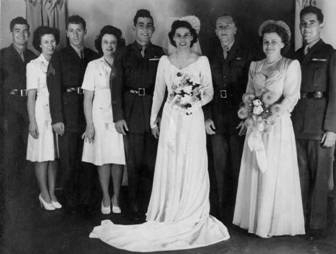
John Basilone and Lena Riggi were married at St. Mary’s Star of the Sea Church in Oceanside, on July 10, 1944. @ John Basilone Biography
Despite the marriage, John always kept a part of himself on duty. He was responsible for training other men how to use a machine gun. But John’s contribution went far beyond that. John built camaraderie between the men and taught them the meaning of esprit de corps. One of his recruits, William Douglas Lansford, said John gave them not only confidence, but pride. “We were ‘Basilone’s Boys’ and were envied throughout the division,” Lansford said.
“He never barked like the other gunnery sergeants but ruled like a wiser, older brother looking after his younger siblings, with humor and a style all his own. Under the hot California sun, with our faces stuck in the dust of Camp Pendleton, he could pick up a draggy machine gun drill with ‘Awright, ya goldbricks. Ya cut the time on settin’ them guns up or don’t expect no liberty come Friday!’ And we did it because we knew he was the best machine gunner in the Corps and we wanted to be like him.”
– William Douglas Lansford
John’s unit was ordered back to the Pacific in late 1944. Though John could have stayed in California with his new wife he insisted on going to war with his men. “I’m staying with my boys. They need me,” he said, according to Lansford. Unfortunately for John, his next battle was to be his last.
Iwo Jima
Iwo Jima was a tiny spec of land between the US-controlled island of Guam and the Japanese home islands. Winning the island and its valuable airbase, would put an end to Japanese air attacks in the area and pave the way for the eventual invasion of the Japanese mainland.
The fighting on Iwo Jima was some of the fiercest of the Pacific campaign. The Japanese fought hard and to the last man – of 22,000 on the island at the start of the battle, only 218 were captured. The rest perished.
Basilone’s last stand
When Gunnery Sergeant John Basilone voluntarily returned to the Pacific war it would be on the sands of Iwo Jima on February 19, 1945. At the head of another machine gun squad, he would drive hundreds of frightened raw troops off the beaches toward their assigned objectives. Iwo would be his toughest fight.
John came ashore with the first wave of Marines on the first day of the Battle of Iwo Jima, February 19, 1945 about 9.30am. The Japanese held their fire at first, waiting the beach to fill up with soldiers before letting loose with machine guns from hidden blockhouses.
John’s unit was pinned down and being taken apart. John knew he had to take action or everyone would be annihilated. He worked his way around the Japanese and got directly on top of one of the blockhouses, then proceeded to single-handedly destroy it with grenades and demolitions.
John then worked his way up the battle-torn beach towards the airfield. He saw an American tank taking fire and trapped in a minefield. John guided it to safety while taking heavy fire.
Lansford, who was also at the battle, said “It seemed nothing could touch him”.
But something did. John was moving along the edge of the airfield with three other marines when they were hit by mortar shrapnel, killing them all. Barely on the island two hours, he was killed leading his men.
John’s actions helped the Marines get off the beach in the early stages of the invasion, which would take over a month to complete. For his actions at Iwo Jima, John Basilone won the Navy Cross, the US Navy’s highest decoration for valor.
Medal of Honor citation
The President of the United States in the name of The Congress takes pride in presenting the MEDAL OF HONOR to SERGEANT fgs JOHN BASILONE UNITED STATES MARINE CORPS for service as set forth in the following CITATION:
For extraordinary heroism and conspicuous gallantry in action against enemy Japanese forces, above and beyond the call of duty, while serving with the 1st Battalion, 7th Marines, 1st Marine Division in the Lunga Area. Guadalcanal, Solomon Islands, on 24 and 25 October 1942. While the enemy was hammering at the Marines’ defensive positions, Sgt. Basilone, in charge of 2 sections of heavy machine guns, fought valiantly to check the savage and determined assault. In a fierce frontal attack with the Japanese blasting his guns with grenades and mortar fire, one of Sgt. Basilone’s sections, with its gun crews, was put out of action, leaving only 2 men able to carry on. Moving an extra gun into position, he placed it in action, then, under continual fire, repaired another and personally manned it, gallantly holding his line until replacements arrived. A little later, with ammunition critically low and the supply lines cut off, Sgt. Basilone, at great risk of his life and in the face of continued enemy attack, battled his way through hostile lines with urgently needed shells for his gunners, thereby contributing in large measure to the virtual annihilation of a Japanese regiment. His great personal valor and courageous initiative were in keeping with the highest traditions of the U.S. Naval Service.
Signed by President Franklin D. Roosevelt
Navy Cross citation
The President of the United States takes pride in presenting the NAVY CROSS posthumously to GUNNERY SERGEANT JOHN BASILONE, UNITED STATES MARINE CORPS
for service as set forth in the following CITATION:
For extraordinary heroism while serving as a Leader of a Machine-Gun Section, Company C, 1st Battalion, 27th Marines, 5th Marine Division, in action against enemy Japanese forces on Iwo Jima in the Volcano Islands, 19 February 1945.
Shrewdly gauging the tactical situation shortly after landing when his company’s advance was held up by the concentrated fire of a heavily fortified Japanese blockhouse, Gunnery Sergeant Basilone boldly defied the smashing bombardment of heavy caliber fire to work his way around the flank and up to a position directly on top of the blockhouse and then, attacking with grenades and demolitions, single handedly destroyed the entire hostile strong point and its defending garrison.
Consistently daring and aggressive as he fought his way over the battle-torn beach and up the sloping, gun-studded terraces toward Airfield Number 1, he repeatedly exposed himself to the blasting fury of exploding shells and later in the day coolly proceeded to the aid of a friendly tank which had been trapped in an enemy mine field under intense mortar and artillery barrages, skillfully guiding the heavy vehicle over the hazardous terrain to safety, despite the overwhelming volume of hostile fire.
In the forefront of the assault at all times, he pushed forward with dauntless courage and iron determination until, moving upon the edge of the airfield, he fell, instantly killed by a bursting mortar shell. Stouthearted and indomitable, Gunnery Sergeant Basilone, by his intrepid initiative, outstanding skill, and valiant spirit of self-sacrifice in the face of the fanatic opposition, contributed materially to the advance of his company during the early critical period of the assault, and his unwavering devotion to duty throughout the bitter conflict was an inspiration to his comrades and reflects the highest credit upon Gunnery Sergeant Basilone and the United States Naval Service.
He gallantly gave his life in the service of his country.
For the President,
JAMES FORRESTAL
Secretary of the Navy

